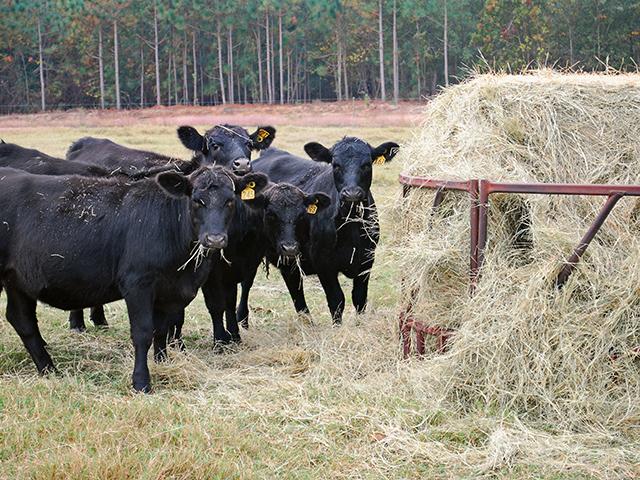What to Look for When Purchasing Hay
Cow-Calf Producers Should Test Hay Nutrient Levels Before Buying
OMAHA (DTN) -- Due to drought conditions last growing season, cow-calf producers may be buying hay to meet their cows' nutritional needs this winter. If they do, producers should be aware that not all hay for sale is the same, and they should consider several factors before opening their checkbook and loading the trailer.
James Rogers, assistant professor at the Noble Research Institute located in Ardmore, Oklahoma, gave a presentation on this topic, titled "Safely Buying Hay -- What to Look For," as part of the virtual Missouri Forage and Livestock Series on Jan. 13. The series runs every Wednesday from Jan. 13 to Feb. 10 (https://extension.missouri.edu/…).
WINTER FEEDS ADD UP
Rogers said winter feed accounts for 60% to 70% of annual costs for a beef-cow herd. However, he said there are practices that can limit how much a producer has to spend for the hay they purchase.
Among the first things to do when considering buying hay is to have the hay tested, he said. Often, the results will also include information on how much nutrients different classes of livestock will need.
Recent research in Oklahoma shows only about 9% of beef producers in the state test their hay to see what nutrients are available, Rogers said. It can be difficult to determine by sight alone how much hay is worth.
During his presentation, he showed a photo of green hay stacked next to brown hay. Then, he showed the results of the hay test: The brown hay was more nutritious than the green hay.
"Appearances can be deceiving," Rogers said.
Once a producer has the results of the test, there are a few things they can look for in the results. First is the dry matter level of the hay, which should be 85% to 90%.
Producers want dry hay, as moisture causes mold to grow, which lowers the quality of the hay. This could also lead to storage issues, he said.
P[L1] D[0x0] M[300x250] OOP[F] ADUNIT[] T[]
Rogers recommended producers try to purchase hay on a per-ton- or per-pound-of-dry-matter basis, not per bale. Bales with a higher percentage of dry matter can often end up costing less than those with lower percentages.
Hay buyers also need to watch for the crude protein level of hay. This level should be 7% or higher, he said.
Producers also need to observe the total digestible nutrients (TDN) percentage of hay. TDN is a useful measurement for beef-cow rations, which are primarily forage.
Rogers said average hay will have a TDN of anywhere from 52% to 59%. Hay with a percentage above this level is more nutritious, while hay testing below is less nutritious.
"Make sure the hay will fit your needs," he said.
FEEDING RULES OF THUMB
Cow-calf producers should follow general feeding rules of thumb, according to Eric Bailey, University of Missouri State beef Extension specialist, who also presented during the webinar.
Crude protein levels for mid- to late-gestation or lactating cows should be in the range from 7% to 11%. Cows not getting this level from forage alone will need to be fed a supplement to receive enough protein, he said.
The TDN for this same grouping would need to be 55% to 65%, he said. Again, if the hay is not proving enough nutrients by itself, a supplement should be fed.
Bailey said poor-quality hay will have under these important levels of nutrients. Feeding supplement will aid in providing nutrients, and producers should target 0.5 to 1 pound of crude protein per day.
An example of this could be 5 pounds of a 20% protein supplement, which will allow the cow to reach the optimum nutrient levels.
"This is where the distillers grain should be (used) to provide some of the protein and energy needs," Bailey said.
Feed costs are changing with grain prices rising in recent months. Usually, hay is among the most expensive feeds, but now, with other feeds more expensive, hay is not as expensive comparatively, he said.
WATCH FEEDING AREAS
Rogers said another consideration when it comes to buying and feeding hay is how the hay is fed and where it is fed.
The types of bale feeders matter, as different round-bale feeders can limit the amount of hay wasted. Open bale rings, for instance, have more waste than cone-style feeders. This style of feeder works well for conserving hay by keeping it off the ground, he said.
Changing the area where hay is fed is also a good practice, Rogers said. Studies have shown that nitrogen, phosphorus and potash levels in the soils where hay is fed continuously can be extremely high.
Rogers suggested producers spread feeders around pastures. The feeders don't have to be moved with every bale fed, but they should be moved every few bales, he said.
Another consideration when purchasing hay is to watch for insects, noxious weeds and nitrates in forages, which also can be tested for, he said.
The Noble Research Institute can be found at https://www.noble.org/….
(c) Copyright 2021 DTN, LLC. All rights reserved.




